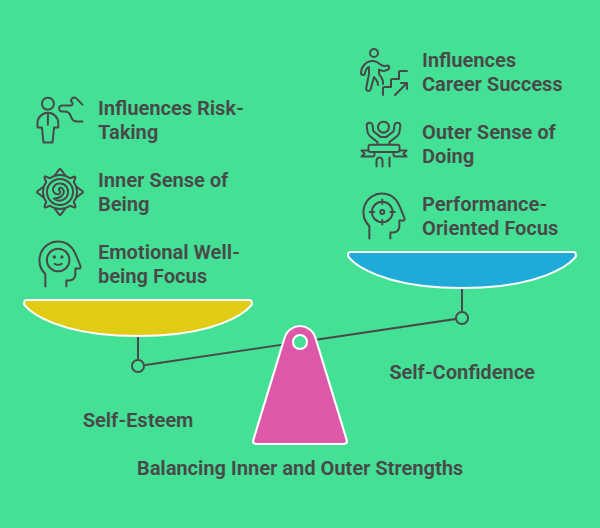Have you ever looked in the mirror and asked yourself, “Am I good enough?” or “Can I do this?” That little voice in your head — sometimes cheering you on, sometimes doubting you — is deeply connected to self esteem and self confidence. For the longest time, I believed they meant the same thing. But I was wrong — they are not the same; they are different. The real twist lies in the idea of self esteem vs self confidence, and how these two shape the way we see ourselves and face the world.
In this article, we’ll dive deep into what sets them apart, how they work together, and why understanding them could be the key to unlocking your full potential. Get comfy, because we’re going beyond surface-level motivation quotes.
What is Self Esteem?
We all long to see ourselves in a positive light and have faith in who we are. But sometimes, there comes a time when our inner self-worth is shaken. Then the question arises — ‘Am I really good? Am I enough?’ This is where self-esteem comes into play. It is our mental foundation, silently shaping our thoughts, behaviors, and even dreams. And to know about this, we need to know: what is self-esteem? Let’s find out what self-esteem is below.

The Core of Self Worth
Self esteem is like your internal compass — it tells you how valuable and worthy you feel at your core. It’s not about what you can do, but who you believe you are. Think of it as the foundation of a house; if it’s shaky, everything built on top will wobble too.
Self esteem shapes your identity, how you view yourself when no one’s watching. It’s quiet, persistent, and often built over years of life experiences.
Internal Validation and Self-Talk
Self esteem feeds off internal validation. You know, those moments when you mess up but tell yourself, “I’m still a good person.” That’s healthy self esteem talking.
Our self-talk — the thoughts and words we use with ourselves — is a mirror reflecting our self esteem. If you constantly call yourself dumb or useless, guess what? You’re digging a pit for your self esteem to fall into.
What is Self Confidence?
Did you know that there is another great aspect of believing in yourself — what is it? It is self-confidence. It is the trust that makes you speak, act, and move forward. Along with self-evaluation, this confidence gives us the strength to turn our dreams into reality. Let’s find out how self-confidence works in our lives.
Trusting Your Abilities
Self confidence, on the other hand, is like the fuel in your car. It’s what helps you take action, speak up in meetings, or try something new. It’s your belief in your capability to succeed in specific situations.
Someone with high self confidence might say, “I’ve never done this before, but I can figure it out.” That doesn’t mean they think they’re flawless — it means they trust their problem-solving skills.
External Actions and Social Context
Unlike self esteem, which lives quietly inside, self confidence often shows up in our actions. It’s visible. It’s the person who raises their hand first in class or volunteers for a big project at work.
Confidence is also more situational. You can be super confident in your cooking but hesitant when it comes to public speaking. It varies.
Self Esteem vs Self Confidence: Breaking It Down
Many times, we think of self-esteem and self-confidence as the same thing. But these two are actually different, and each plays an important role in our lives.
One is an inner feeling — what you really think about yourself. The other is an outer manifestation — how capable you think you are at doing something.
If you understand the idea of self esteem vs self confidence, you will be able to grasp your behavior, thoughts, and mental strength much more clearly.
Let’s now put these two concepts side by side and analyze them a little better. Finally, I will present them in the form of a table.

Key Differences in Psychology
Psychologically speaking, self esteem is tied to emotional well-being, while self confidence is tied to performance. Self esteem is your sense of being; self confidence is your sense of doing.
Here’s a simple metaphor: if self esteem is the soil, self confidence is the plant. The healthier the soil, the more vibrant the plant.
How They Influence Behavior
People with high self confidence but low self esteem might succeed in their careers yet feel empty inside. Conversely, those with strong self esteem might be content but hesitant to try new things.
These inner dynamics influence risk-taking, relationships, and how resilient we are in the face of failure.
| Aspect | Self Esteem | Self Confidence |
| Psychological Basis | Tied to emotional well-being and self-worth | Tied to abilities, performance, and achievements |
| Core Meaning | Your sense of being—how you feel about who you are | Your sense of doing—how you feel about what you can do |
| Metaphor | Like the soil—it nourishes everything else | Like the plant—it shows what’s growing from within |
| Behavioral Impact | May feel whole inside but hesitate to take on challenges | May take on challenges but feel unfulfilled or insecure inside |
| Response to Failure | Helps you feel worthy even when things go wrong | Helps you recover and try again after setbacks |
| Life Influence | Builds resilience, inner peace, and emotional stability | Fuels achievement, risk-taking, and bold actions |
The Psychology Behind Self Esteem and Self Confidence
Did you know that self-esteem and Self-confidence actually develop over time? Our emotional foundation is formed through a combination of experiences, social influences, and emotional responses. In this section, we’ll explore how this inner structure develops and how different factors affect it. We’ll also learn about the psychology behind it.
Roots in Childhood and Development
Both traits begin forming early in life. Kids who receive encouragement, safe environments, and healthy boundaries tend to grow with stronger self esteem and confidence.
Negative feedback, neglect, or trauma can lead to distorted self-images and shaky confidence levels later on.
Nature vs. Nurture Debate
Are we born with good self esteem? Some psychologists argue yes — to a degree. But nurture plays a massive role. If you’re curious about how this debate shapes our self-perception, explore more on Nature vs. Nurture Debate.
Why You Need Both
We often end up fixing one side while forgetting the other. Yet, both inner feelings and outer expression are essential for our mental well-being. In this section, let’s explore why having both of these qualities together is so important, and how balancing them can have a real impact on our lives.
The Balance Equation
Think of self esteem as the roots and self confidence as the wings. You need both to grow and soar. Without esteem, your confidence becomes fragile. Without confidence, your esteem stays hidden.
The healthiest individuals find a balance: they know their worth and believe in their abilities.
Real-Life Implications
Balanced individuals handle criticism better, rebound faster from setbacks, and build stronger relationships. It’s like having emotional armor that still allows for vulnerability and growth.
Self Esteem vs Self Confidence Examples
We have discussed a lot of theories above; now let’s take a look at reality and see how it plays out in real life. If we understand how self-esteem and self-confidence manifest differently in real-life situations, the difference between the two will become clearer.
Workplace Scenarios
Imagine Sarah. She’s great at presentations (high confidence) but constantly seeks approval (low esteem). Then there’s Alex, who doesn’t speak much in meetings (low confidence) but knows his value (high esteem).
See the difference?
Personal Life Comparisons
In personal life, someone with high esteem might end a toxic relationship without doubting their worth, while someone with high confidence might be the life of the party but still feel unloved inside.
Boosting Self Esteem
Daily Practices and Habits
Gratitude journaling, affirmations, and setting healthy boundaries are esteem boosters. It’s all about treating yourself with respect even when no one else is watching.
Celebrate your efforts, not just outcomes. That inner voice needs to hear your wins.
Cognitive Behavioral Techniques
CBT tools like thought records help you catch and challenge negative beliefs. Replacing “I’m a failure” with “I’m learning and improving” rewires your mental patterns. For a deeper understanding of how CBT works, check out this comprehensive guide on Cognitive Behavioral Therapy.

Building Self Confidence
Skill Mastery and Practice
Confidence grows with competence. The more you practice a skill, the easier it becomes. Think of learning to ride a bike — scary at first, but eventually second nature.
Begin with small steps, celebrate victories, and grow your comfort zone.
Social Exposure and Risk Taking
Put yourself out there. Join a new group, speak in a meeting, say yes to that opportunity. Confidence is like a muscle — the more you use it, the stronger it gets.
Failure? It’s just feedback.
Common Misconceptions
Many of us have misconceptions about self-esteem and confidence. Sometimes, we confuse them with arrogance or self-praise. In this section, we’ll look at what we’re actually misunderstanding — and what the truth really is.
Arrogance vs Confidence
- Confidence is quiet; arrogance is loud.
- Confidence lifts others; arrogance proves itself.
- One earns respect, the other invites pushback.
Humility & Esteem
- High self-esteem means you’re enough, not superior.
- Humility and self-worth work together — like PB&J.
Frequently Asked Questions (FAQs)
1.How do self esteem and self confidence differ?
Esteem is about who you are; confidence is about what you can do.
2.Can you have self confidence but low self esteem?
Yes. You might appear capable but still struggle with self-worth inside.
3.Can you have high self esteem and low confidence?
Absolutely. You may value yourself deeply but fear taking risks or failing publicly.
4.How can I improve self esteem?
Start with self-compassion, positive self-talk, and boundary setting.
5.How can I build self confidence?
Practice skills, face fears gradually, and celebrate small wins.
6.What’s more important: esteem or confidence?
Both matter. Esteem builds emotional resilience; confidence drives action.
6.Are self esteem and self confidence genetic?
There’s a genetic influence, but environment and experiences shape them significantly.
7.Does culture affect self esteem and confidence?
Yes. Cultural values shape how we view ourselves and our achievements.
8.Is arrogance the same as confidence?
No. Arrogance comes from insecurity; confidence comes from assurance.
9.Can therapy help with self esteem?
Definitely. Therapists use evidence-based tools to build self-worth.
10Do social media affect self esteem?
Yes, especially through comparison and unrealistic portrayals of life.
All in all of this article
Self esteem vs self confidence is not a battle—it’s a partnership. One is the silent belief that you matter; the other is the bold action you can take. Knowing the difference can change yourself, your goals, and even your failures. Build both. Nurture both. Live with both.
Hello friends, how did you like my article? If you liked it, share it on your social media and let your friends read it. Who knows, they might be interested in this topic.

